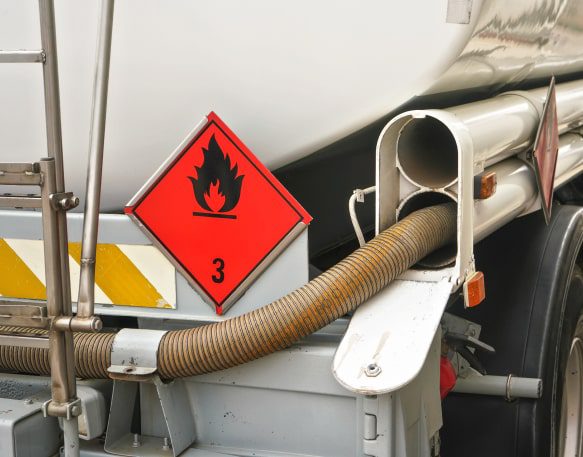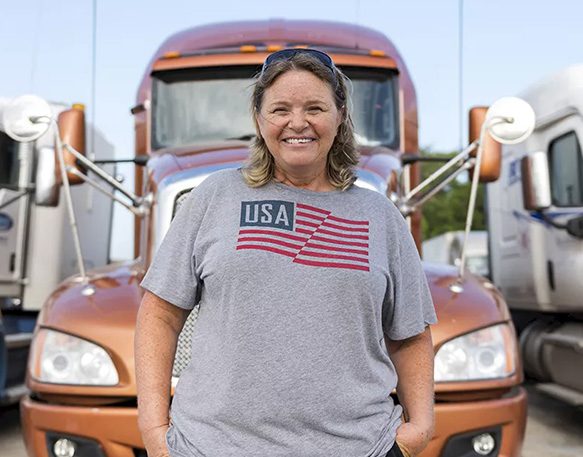From properly handling the cargo to keeping drivers safe and secure on the road, hazmat carriers must account for many moving parts at all times of the freight journey.
In this introductory guide to hazmat hauling, we will cover the nuts and bolts of hazmat trucking as well as the various steps one must take to be a legally certified hazmat driver. We will also walk you through the safety tips and best practices that the most effective hazmat fleets swear by.
What is hazmat hauling?
Hazmat is short for hazardous materials. Hazmat hauling is a classic case of risk and reward. Broadly speaking, hazmat freight involves the hauling of dangerous materials. More specifically, the Institute of Hazardous Materials Management classifies hazardous materials across nine distinct categories:
- Corrosives
- Explosives
- Gasses
- Flammable Liquids
- Flammable Solids
- Miscellaneous Dangerous Goods
- Organic Peroxides / Oxidizing Substances
- Radioactive Materials
- Toxic and Infectious Substances
As you can see, whether it’s radioactive waste or toxic gasses, there is a wide range of materials that are classified as hazardous. Carriers typically search through hazmat load boards to find new hazmat loads. If you’re ever in doubt if a particular load fits the hazmat criteria bill, a good rule of thumb to keep in mind is that if cargo has the potential to do damage either on its own or when brought into contact with water, air, flames, or other chemicals, chances are the cargo is hazardous.
The most crucial piece of hazmat trucking is driver, vehicle, and cargo safety. Drivers permitted to legally haul hazmat go through rigorous training, earning specific licenses and registrations depending on their specific line of freight. At all stages of the freight journey, hazmat drivers take on extra responsibilities beyond most other trucking types.
When planning cargo routes, hazmat haulers must avoid designated hazmat-restricted areas.
How can you haul hazardous materials?
There’s a reason why hazmat drivers get paid handsomely for their services. Given the significant dangers and costs (training, equipment, etc.) involved with hauling hazmat materials, hazmat carriers often receive premium rates relative to more traditional trucking jobs. In 2021, while the average take-home pay for a dry van driver totaled $65,500, the total compensation for the driver of a Class Z CDL/Driver HazMat Tanker averaged roughly $86,000 – about 31% more.
But to take advantage of this lucrative line of trucking and legally transport hazardous materials, applicants must complete a series of stringent steps, such as:
1. Obtain a valid commercial driver’s license (CDL) – Any driver certified to haul large quantities of hazardous cargo possesses a valid and active Commercial Driver’s License (CDL – Class A). While specific CDL requirements vary by state, most states mandate specific training periods, where applicants are permitted to practice driving as long as another driver with a valid CDL accompanies them. Once the permit phase is over, applicants have two options: they can successfully pass a driving aptitude test at a local DMV or earn a verified endorsement from an employer or DMV-certified training center.
2. Earn your hazmat endorsement – Once you have your CDL in hand, you’ll need to obtain your hazmat endorsement. Since the hazmat industry remains governed by strict safety standards, the hazmat endorsement can often be a rigorous process. Applicants are required to file a separate Hazmat application, complete a series of extra steps, and meet certain eligibility requirements, which include:
- Submitting valid proof of identification (the minimum age requirement for hazmat hauling is 21 years old).
- Providing valid proof of citizenship or legal residence.
- Passing medical and eye exams.
- Successfully passing a test designed to measure your hazmat acumen.
- Successfully passing a thorough background check conducted by the Transportation Security Administration (TSA)
The fee to submit your Hazmat application costs between $80-$110, while the background check alone can alone stretch more than 60 days. While you will have to pass a screening conducted by the to get your CDL, the TSA runs separate, more intensive background checks for hazmat applicants. If you’re unsure of your eligibility status, the TSA outlines a full list of offenses – mostly criminal convictions – that immediately disqualify hazmat driver applicants from being considered for certification.
3. Pursue additional certificates (according to your vehicle and line of hazmat trucking) – Once you successfully earn your Hazmat Endorsement, you may want to get a tanker endorsement, among any other additional certificates that may be relevant to your business. Earning your tanker endorsement can come in handy and qualify you for high-paying jobs, given how popular tankers are for transporting large quantities of hazardous, often flammable, materials. In fact, many transport companies will require drivers to have both their hazmat and tanker endorsements.
The good news is that you can train for both certifications at the same time and combine your HazMat endorsement (H) and tanker endorsement (N) as an “X” endorsement on your CDL. Whether you pursue each endorsement separately or concurrently, you will ultimately need to pass separate knowledge tests for each certification.
From a driver’s standpoint, going after your “X” endorsement makes sense if your goal is to create as many business opportunities as possible. An “X” endorsement certifies you to transport a variety of hazardous substances and helps you stand out from the competition. Hazmat trucking rules and regulations are enforced at the state and federal levels. Hazmat requirements vary by state, so before you start your application process, check your state’s specific hazmat laws.
Safety tips for effective hazmat hauling
For hazmat trucking companies, it remains the employer’s fundamental and ongoing responsibility to identify any material that may be hazardous. In addition, hazmat trucking companies must comply with relevant state and federal authorities.
Investing in driver safety is not a bad place to start if you want to attract ready-made talent and grow your hazmat fleet. Drivers with a proven hazmat track record can capitalize on market conditions – while demand for hazmat hauling services shows no signs of slowing down, high barriers to entry and attrition rates leave fleets in short supply of qualified drivers.
Given the personal and professional liabilities hazmat drivers sign on for themselves, it’s understandable most hazmat drivers expect their employer to share an equal commitment to safety. Before joining your fleet, drivers will want to know your track record on accidents, safety, and compliance.
Below are vital safety measures surrounding hazmat trucking that carriers must take to attract top talent, prevent accidents, and stay out of trouble:
Proper PPE use – Hazmat hauling relied on PPE long before the global pandemic. Hazmat companies must provide all their employees who handle hazardous materials with PPE and appropriate PPE training. Employees should diligently inspect all PPE items before each use, with the ability to identify worn-out or damaged PPE. Damaged PPE becomes an inadequate form of protection from hazardous materials and needs to be immediately replaced.
Check for container labels – Hazmat loads, items, and cargo should always be marked with a clearly designated label. The container’s label and Material Safety Data Sheets (MSDSs) are the two primary sources of information that keep employees informed of hazards and necessary precautions. Employees should always confirm the label before handling any container that might be hazardous. Employees should immediately notify their supervisor if they come across a container without a label or one that remains illegible.
Minimize contamination and cross-contamination risks – Trucking companies that handle hazmat loads must keep cleaning equipment available and easily accessible for employees. We recommend that all work surfaces are routinely cleaned at least once per shift to reduce contamination risks. Before and after working with any hazardous materials, employees should frequently wash their hands with soap and water. Drivers should also refrain from eating, drinking, using cosmetics, and using contact lenses if there is a risk of contamination. Reminding your drivers of these basic rules of thumb can help safeguard your fleet against avoidable mistakes.
Drill down emergency protocols – All companies that handle hazmat materials must establish clear emergency protocols and ensure they are communicated across the company to employees. New employees should be properly trained on existing procedures through the onboarding phases, while additional training on best practices might be deemed appropriate for more seasoned employees. Effective risk management begins by communicating your emergency procedures to new drivers and placing your core safety measures at the heart of your fleet’s day-to-day operations.
Additional best practices to keep in mind when hauling hazmat:
Hazmat hauling companies and their drivers employ a number of best practices to keep each hazmat delivery as safe as possible, including:
- Driver mentorship programs: Developing mentorship programs that allow the greenest hazmat drivers in the fleet to be taken under the wing of more seasoned veterans. By providing a forum for drivers in the field to share lessons learned along the way, mentorship programs can fill in knowledge gaps across the fleet and accelerate driver development.
- Advanced route planning: It’s critical to design and communicate optimal hazmat hauling routes ahead of time. The last thing you want is a situation where your driver detours mid-journey to avoid fines and penal zones. Planning ahead and empowering your driver with all the relevant information he needs ahead of time bolsters driver safety, public safety, and the surrounding environment and is the best way to avoid in-transit delays.
- Driver training(s): Training programs and initiatives can be a great way to ensure your fleet of hazmat haulers remain in touch with best hazmat practices. By offering regular training and multiple development pathways, drivers can be trusted to stay vigilant on the roads and safely perform their most dangerous hazmat duties.
Whether you subsidize or incentivize your drivers to pursue various licenses and designations is up to you, but long term, the payoff is worth it. Generally speaking, the more you invest in your hazmat drivers’ continued success, the more bottom-line impact you’ll start to see your drivers deliver for your business. - Maintenance and inspection: The best hazmat fleet managers remain proactive in their fleet management. Preventive vehicle maintenance minimizes fleet-wide downtime and ensures you stay in compliance with inspection processes. In short, spending a little time in the shop today can save your hazmat truck that much more time spent in the repair shop tomorrow.
Get ahead with DAT
Now that you know the ins and outs of hazmat trucking, once you’ve taken care of the steps involved in becoming a hazmat hauler, it’s time to start growing your business. The best way to boost your bottom line and find the most lucrative hazmat loads is through the DAT Load Board. For a simple, flat monthly rate that comes without hidden fees, hazmat haulers around the country tap into the most powerful freight network in the industry to win new business.
DAT’s hazmat load board features exclusive hazmat listings each business day. Hazmat haulers take advantage of instant alerts and powerful search and posting capabilities to find the most valuable nearby hazmat loads quickly. Meanwhile, the free-to-download, all-in-one DAT One Mobile app helps hazmat haulers connect to DAT’s hazmat load board and run their business with maximum efficiency, even when they’re on the go.
Ready to get started with the most trusted load board in the business? Speak with the experts at DAT today to learn more about the DAT Load Board and other services for hazmat haulers!
Find top hazmat loads with DAT!
No matter what kind of freight you’re looking for, there’s no better place to search for it than the DAT load board, the largest freight marketplace in the industry. With 644,500 new posts every day that cover every type of vehicle and freight, there are always new opportunities to discover on the DAT load board. Try it out today!




